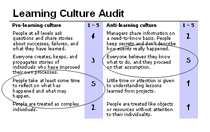
With this new year, you may be looking frantically for a new way to improve your organization’s competitiveness, talent, staying power, and smarts. You’re not alone.
When senior leaders of a giant materials manufacturer realized their people were not innovating as quickly as the market demanded–and slower than competitors–they assumed replacing several hundred people was a logical next step. They brought me in to reimagine their recruiting, talent management, and leadership development program. They anticipated needing dramatically different approaches than those they’d relied on for almost a century. Before we started, I spent time learning about their organizational culture, wanting to ensure new team members would be able to excel where the old team could not.
Although we spent a month assessing capabilities and gaps, a learning culture audit proved to be the most effective lever. Developed almost a decade ago, as part of writing my book Creating a Learning Culture, the straightforward model proved invaluable. We quickly learned their approach to leadership and sharing knowledge was unraveling the company’s success. “Oh,” said the head of technical strategy, “being so confident in our plans, we’re stifling how our employees work.” “Yes, and,” I replied, “this isn’t just an employee problem. The leadership team probably isn’t readying itself for what’s next.”
 Organizational culture is one of many places where learning does not equal training. A learning sensibility (coupled with applying the right lessons fast) is the core competency that separates successful companies from those struggling to survive. When people are learning all they need and helping one another learn fast, they can make smart decisions and adapt quickly to constant change.
Organizational culture is one of many places where learning does not equal training. A learning sensibility (coupled with applying the right lessons fast) is the core competency that separates successful companies from those struggling to survive. When people are learning all they need and helping one another learn fast, they can make smart decisions and adapt quickly to constant change.
In this corporation’s case, they had the people they needed. They had a workforce of bright, creative people eager to solve problems in new ways. They just also had endless obstacles in people’s paths stopping people from doing what needed to be done. By breaking long-standing patterns and clearing away the practices that seemed like good ideas when they were launched, but together were maddening, we ended up reinventing their people strategy for their existing workforce, people desperate to work in new ways.
Conducting a simple learning culture audit can help you assess your organization and your leadership team’s orientation to continuously learn and apply what they’re learning. Examining the characteristics of cultures that encourage or block learning provide a way to see how well you’re fostering an environment where people glean new insights and get stronger now.
Consider each question carefully. Think about your behavior and that of your colleagues. You might also want employees to complete such a survey to get a sense of how they perceive you and the entire organization are doing.
By taking your organization through this audit, you demonstrate your willingness to ask tough questions and hear answers that are honest rather than reassuring. The self-assessment should take no more than 10 minutes and the lessons learned can focus your organization for at least the next year.
Instructions: Rank your organization on each characteristic along a scale of 1 to 5, 1 being always no and 5 being always yes. At the bottom, tally the rankings to determine if your organization has more of a pro-learning or an anti-learning culture. Circle the items in each category that require special attention from you in the coming days, weeks, and year.
|
Pro-learning culture |
1–5 |
Anti-learning culture |
1–5 |
|
People at all levels ask questions and share stories about successes, failures, and what they have learned. |
Managers share information on a need-to-know basis. People keep secrets |
||
|
Everyone creates, keeps, and propagates stories of colleagues who have improved their own processes. |
Everyone believes they know what to do, and they proceed on that assumption. |
||
|
People take time regularly to reflect on what has happened and what may happen. |
Little time or attention is given to understanding lessons learned from |
||
|
People are treated as complex individuals. |
People are treated like objects or resources without attention to their |
||
|
Managers encourage continuous experimentation. |
Employees proceed with work only when they feel certain of the outcome. |
||
|
People are hired and promoted on the basis of their capacity for learning and adapting to new situations. |
People are hired and promoted on the basis of their technical expertise |
||
|
Performance reviews include and pay attention to what people have learned. |
Performance reviews focus almost exclusively on what people have done. |
||
|
Senior managers participate in training programs designed for new or high-potential employees. |
Senior managers only kick off management training programs, rarely facilitating conversations or courses. |
||
|
Senior managers are willing to explore their underlying values, assumptions, beliefs, and expectations. |
Senior managers are defensive and unwilling to explore their underlying |
||
|
Conversations in management meetings constantly explore the values, assumptions, beliefs, and expectations underlying proposals and |
Conversations tend to move quickly to blaming and scapegoating with little attention to the process that led to a problem or how to avoid it in the future. |
||
|
Customer feedback is solicited, actively examined, and included in the next operational or planning cycle. |
Customer feedback is not solicited and is often ignored when it comes in |
||
|
Managers presume that energy comes in large part from learning and growing. |
Managers presume that employee energy comes from corporate success and profits. |
||
|
Managers think about their interest in and capacity for learning new things (their learning quotient), and the learning quotient of their employees. |
Managers think that they personally know all they need to know and that their employees do not have the capacity to learn much than they know. |
||
|
Total for pro-learning culture
|
|
Total for anti-learning culture |
|
The column with the highest total represents the type of culture you have today.
If you’re interested in distributing a copy of this assessment to the people you work with, download a copy at http://j.mp/LCAprint. More, much more, on creating a learning culture can be found in my article “Create a Learning Culture” (Fast Company online resource center) and the book Creating a Learning Culture: Strategy, Technology, and Practice (Cambridge, UK; Cambridge University Press, 2004). If you sign up for my blog updates, you’ll be notified when I post blocks of text from that book to this site in the coming weeks. In the meantime, you can read the first chapter by Harlan Cleveland.
Happy New Year.
[Image: CC image by ThomasHawk, Fireworks 4]
